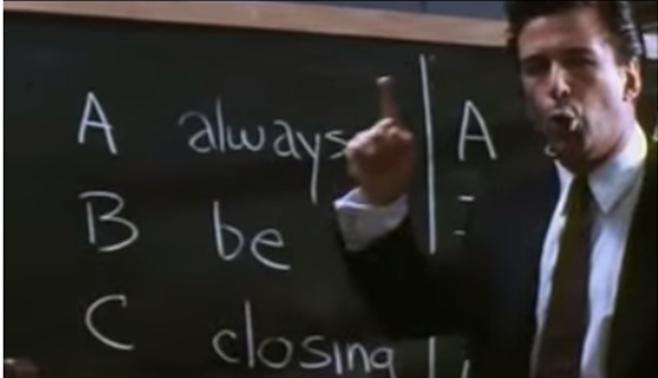Do you know what your ideal sales process looks like?
In the movie “Glenngary Glen Ross”, there is a well-known speech by Alec Baldwin to a team of salespeople where he preaches the concept of “ABC: Always Be Closing”. If you haven’t seen the movie, the main message in the speech is that you should always be trying to close the prospect, and if you aren’t, then you don’t belong in sales.
**Caution: Profanity throughout this clip**
But should you really “Always Be Closing”? The answer to that is both yes and no.
Yes – Always Be Closing
Yes, in every conversation that you have with a prospect, you should always be closing. But the important thing here is what you are always closing for.
The trap that we naturally fall into is to always try to close the prospect on purchasing our products or services. Even if we don’t actually ask the prospect direct closing questions, we still often come at an angle of determining if the prospect is going to buy or not.
No – Don’t Always Be Closing for the Sale of Your Product
But the important thing to not lose sight of is that closing the sale is usually not the very next step in your sales process. More often than not, there are many steps that you will need to take the prospect through, and it is the next step in your process that you should always be closing on.
Close on Scheduling an Appointment
Take an example where you are talking to a prospect for the very first time, either on a cold call or maybe you are talking at a networking event. This person you are talking to could actually end up buying from you but it is not realistic for them to buy from you after a 2 to 5-minute conversation (this does not apply if the product is a one-call close).
As a result, if you try to close on selling your product in this 2 to 5 minutes, you are likely to not have enough time to build interest, and you can often end up with a prospect either saying or thinking, “I am not interested.”
For many salespeople, a good next or first real step in an ideal sales process is to have a real conversation with the prospect. Not the 2 to 5-minute initial contact, but usually something more like a 20 to 30-minute conversation where you can learn more about the prospect and share how you can help. This could be in person or over the phone. You may call this conversation an appointment in your business, or you may call it something else like “meeting over a cup of coffee”.
When you are at the beginning of the sales cycle, if you shift from focusing on closing for the product and moving toward closing on trying to set the appointment, you can greatly improve your results. You are not pushing something on the prospect that they do not want yet (your product), and a conversation is also something that is much harder for the prospect to object to.
“I am not interested” is a valid reason to not purchase but it is not a good reason to not have a conversation. Remember, you are not trying to sell anything – you are trying to have a conversation.
Always Close on the Next Step in the Sales Process
This logic can continue as you progress through the sales cycle. Every time you talk with the prospect, there is always a next step. Once you get beyond the first appointment, there may be steps like more formal meetings, follow-up conversations, presentations, proposals, etc.
Always have clarity around what your ideal sales process looks like in terms of steps, and then focus on always be closing for the step that you need to take next.
